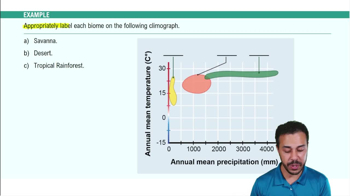Table of contents
- 1. Introduction to Biology2h 42m
- 2. Chemistry3h 40m
- 3. Water1h 26m
- 4. Biomolecules2h 23m
- 5. Cell Components2h 26m
- 6. The Membrane2h 31m
- 7. Energy and Metabolism2h 0m
- 8. Respiration2h 40m
- 9. Photosynthesis2h 49m
- 10. Cell Signaling59m
- 11. Cell Division2h 47m
- 12. Meiosis2h 0m
- 13. Mendelian Genetics4h 44m
- Introduction to Mendel's Experiments7m
- Genotype vs. Phenotype17m
- Punnett Squares13m
- Mendel's Experiments26m
- Mendel's Laws18m
- Monohybrid Crosses19m
- Test Crosses14m
- Dihybrid Crosses20m
- Punnett Square Probability26m
- Incomplete Dominance vs. Codominance20m
- Epistasis7m
- Non-Mendelian Genetics12m
- Pedigrees6m
- Autosomal Inheritance21m
- Sex-Linked Inheritance43m
- X-Inactivation9m
- 14. DNA Synthesis2h 27m
- 15. Gene Expression3h 20m
- 16. Regulation of Expression3h 31m
- Introduction to Regulation of Gene Expression13m
- Prokaryotic Gene Regulation via Operons27m
- The Lac Operon21m
- Glucose's Impact on Lac Operon25m
- The Trp Operon20m
- Review of the Lac Operon & Trp Operon11m
- Introduction to Eukaryotic Gene Regulation9m
- Eukaryotic Chromatin Modifications16m
- Eukaryotic Transcriptional Control22m
- Eukaryotic Post-Transcriptional Regulation28m
- Eukaryotic Post-Translational Regulation13m
- 17. Viruses37m
- 18. Biotechnology2h 58m
- 19. Genomics17m
- 20. Development1h 5m
- 21. Evolution3h 1m
- 22. Evolution of Populations3h 53m
- 23. Speciation1h 37m
- 24. History of Life on Earth2h 6m
- 25. Phylogeny2h 31m
- 26. Prokaryotes4h 59m
- 27. Protists1h 12m
- 28. Plants1h 22m
- 29. Fungi36m
- 30. Overview of Animals34m
- 31. Invertebrates1h 2m
- 32. Vertebrates50m
- 33. Plant Anatomy1h 3m
- 34. Vascular Plant Transport1h 2m
- 35. Soil37m
- 36. Plant Reproduction47m
- 37. Plant Sensation and Response1h 9m
- 38. Animal Form and Function1h 19m
- 39. Digestive System1h 10m
- 40. Circulatory System1h 49m
- 41. Immune System1h 12m
- 42. Osmoregulation and Excretion50m
- 43. Endocrine System1h 4m
- 44. Animal Reproduction1h 2m
- 45. Nervous System1h 55m
- 46. Sensory Systems46m
- 47. Muscle Systems23m
- 48. Ecology3h 11m
- Introduction to Ecology20m
- Biogeography14m
- Earth's Climate Patterns50m
- Introduction to Terrestrial Biomes10m
- Terrestrial Biomes: Near Equator13m
- Terrestrial Biomes: Temperate Regions10m
- Terrestrial Biomes: Northern Regions15m
- Introduction to Aquatic Biomes27m
- Freshwater Aquatic Biomes14m
- Marine Aquatic Biomes13m
- 49. Animal Behavior28m
- 50. Population Ecology3h 41m
- Introduction to Population Ecology28m
- Population Sampling Methods23m
- Life History12m
- Population Demography17m
- Factors Limiting Population Growth14m
- Introduction to Population Growth Models22m
- Linear Population Growth6m
- Exponential Population Growth29m
- Logistic Population Growth32m
- r/K Selection10m
- The Human Population22m
- 51. Community Ecology2h 46m
- Introduction to Community Ecology2m
- Introduction to Community Interactions9m
- Community Interactions: Competition (-/-)38m
- Community Interactions: Exploitation (+/-)23m
- Community Interactions: Mutualism (+/+) & Commensalism (+/0)9m
- Community Structure35m
- Community Dynamics26m
- Geographic Impact on Communities21m
- 52. Ecosystems2h 36m
- 53. Conservation Biology24m
48. Ecology
Introduction to Ecology
Problem 19
Textbook Question
In the climograph below, biomes are plotted by their range of annual mean temperature and annual mean precipitation. Identify the following biomes:
Arctic tundra
Coniferous forest
Desert, grassland
Temperate forest,
Tropical forest.
Explain why there are areas in which biomes overlap on this graph.

 Verified step by step guidance
Verified step by step guidance1
Examine the climograph provided. Each labeled region (a, b, c, d, e, f) represents a biome based on its range of mean annual temperature (°C) and mean annual precipitation (cm). Identify the biomes by matching their environmental conditions to the graph.
Label 'a' corresponds to the desert biome, characterized by low precipitation (less than 100 cm annually) and high temperatures (up to 30°C). Deserts are typically dry and hot.
Label 'b' corresponds to the grassland biome, which has moderate precipitation (around 100-200 cm annually) and temperatures ranging from 0°C to 30°C. Grasslands are found in regions with seasonal rainfall.
Label 'c' corresponds to the tropical forest biome, which experiences high precipitation (300-400 cm annually) and warm temperatures (above 20°C). Tropical forests are located near the equator and have consistent rainfall.
Biomes overlap on the graph because environmental conditions such as temperature and precipitation can vary within a biome, creating transitional zones. For example, grasslands may share characteristics with deserts or temperate forests depending on local climate variations.
 Verified video answer for a similar problem:
Verified video answer for a similar problem:This video solution was recommended by our tutors as helpful for the problem above
Video duration:
3mPlay a video:
Was this helpful?
Key Concepts
Here are the essential concepts you must grasp in order to answer the question correctly.
Climograph
A climograph is a graphical representation that displays the relationship between temperature and precipitation in a specific area over a year. It helps in visualizing climate patterns and understanding how these factors influence the distribution of biomes. By plotting mean annual temperature against mean annual precipitation, climographs can illustrate the conditions that define different ecosystems.
Recommended video:
Guided course

Terrestrial Biomes: Near Equator Example 1
Biome
A biome is a large ecological area on the Earth's surface, characterized by specific climate conditions, flora, and fauna. Examples include tundra, forests, deserts, and grasslands. Each biome has distinct temperature and precipitation ranges that support particular types of vegetation and animal life, which can be identified on a climograph based on their respective climatic conditions.
Recommended video:
Guided course

Introduction to Aquatic Biomes
Biome Overlap
Biome overlap occurs when different biomes share similar ranges of temperature and precipitation, leading to areas where their characteristics can blend. This can happen due to transitional zones, where environmental conditions are not strictly defined, allowing for a mix of species and ecosystems. Understanding this overlap is crucial for studying biodiversity and ecological interactions within these regions.
Recommended video:
Guided course

Introduction to Aquatic Biomes
Related Videos
Related Practice
Textbook Question
Tropical rain forests are the most diverse biomes. What factors contribute to this diversity?
2263
views


